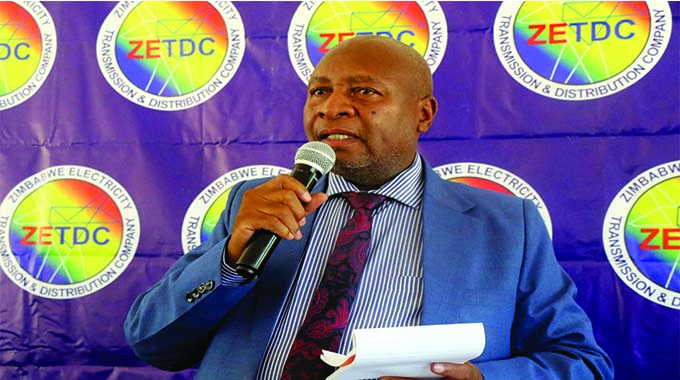WATCH: Zesa to connect electricity to at least three million rural households

Nqobile Tshili, [email protected]
ZESA Holdings (Zesa) has unveiled an ambitious plan to connect electricity to at least three million rural households over the next four years to buttress the Government’s transformative development drive.
Matabeleland North, Matabeleland South and some parts of Manicaland have the least areas connected to electricity and going forward these will be prioritised in provision of power, Zesa executive chairman, Dr Sydney Gata said on Friday.
He was speaking during a Zesa stakeholders meeting held at Whitewater High School in Matobo District where Energy and Power Development Minister, Edgar Moyo, who is also Matobo MP was the guest of honour.
Dr Gata welcomed the Government’s plan to restructure Zesa saying the move will enable the power utility company to deliver on its mandate.
The restructuring process will result in a new tariff regime being introduced while its operations will also be transformed to enhance business efficiencies.
Cabinet last week Tuesday approved Zesa’s restructuring as the country moves towards energy self-sufficiency, which is critical in unlocking more investments.
Dr Gata said electricity provision and data form the solid base upon which economic and social development can be achieved. He said for the past 14 years, Zesa has been providing electricity at an unsustainable rate, which was crippling operations.
This makes the restructuring of the parastatal an important factor as electricity and broadband services are part of the sustainable development goals. Zesa provides broadband services through its subsidiary, Powertel.

“Zesa is born again. I will explain briefly why I’m saying this. When the minister was appointed the first thing he did was to interact with institutions under his leadership including Zesa and other parastatals,” said Dr Gata.
“I was very surprised how quickly he was able to grasp the things that were destroying this industry. The question above all is one of the cost-effective tariffs.
“Zesa for the past 14 years has been selling electricity below cost.”
As a result, the Zesa executive chairman said the power utility has been operating on a shoestring budget, resulting in projects including new connections being stagnant. He made reference to structural changes that were done without adequate consultations, which have stifled the growth of the sector.
“They did not produce what they were aimed for. Our laws have created two institutions Zesa and Rural Electrification Agency (REA).
“Ordinarily the work we are embarking on now should have been done by REA. I was fortunate to be the first chairman of REA when it was first established and at that time there was a relationship between REA and Zesa, which was very strong,” said Dr Gata.
“But somehow somewhere somebody changed that relationship and both organisations were weakened in their capacity to electrification in rural areas.”
While the two organisations were working in unison, they could connect a school with electricity on regularly but all the changes weakened the institutions.
Dr Gata said the appointment of Minister Moyo and the expected restructuring of the sector will deliver on the glorious past of Zesa and REA.

Dr Sydney Gata
“What I can say now in conclusion is that the minister has already created the parameters for us to pick up that speed. He has already corrected the tariff,” he said.
“In his first two to three meetings in Cabinet, he stood up to deliver a tariff structure that is capable of extending the grid to all rural communities.
“Secondly, he supported us in a plan that makes up for structural changes. We said we are not going to sit back but we are going to have a ‘cousin kind’ of programme for Zesa to assist REA,” said Dr Gata.
He said the power utility has come up with a total electrification strategy for the country of Zimbabwe through grid and solar energy.
“We have a rural home lighting system. We have on order and we got to deliver perhaps in the first quarter as we get finance, we are going to provide up to three million home lighting kits so that by the end of 2028 at the most, everyone has got some form of electricity at their home. Those who are far away from the grid will benefit home lighting kits,” said Dr Gata.
“We are not going to bring zhing-zhong, we are bringing equipment that has been tested in Rwanda, equipment that has been tested in some parts of Mozambique and equipment that has been employed in some parts of Ghana.
“We did a survey to find the best reliable technology to be found in rural areas. So, every homestead in the next four years at most will have the capacity to have lights, small television, a small fridge powered by solar.”
Dr Gata said the broader plan is to have all the households connected to grid power by 2030 in line with President Mnangagwa’s Vision 2030.
He said the restructuring of Zesa is also expected to bring more investors in the energy sector.
Dr Gata said he was aware that due to historic political issues, areas in Matabeleland region were marginalised developmentally, hence, in the electrification programme, they will be prioritised.
“This area, Matabeleland North, Matabeleland South, Chipinge where I come from, that is why I’m excited and in Chimanimani, on our statistics they lag behind on electrification,” he said.
“But the President has said no place and no one must be left behind by the Second Republic. The President has allowed us to be able to deploy extra measures for these depressed areas to catch up with the rest of the country,” said Dr Gata.
He said going forward these areas will be allocated more resources so that they match up with other parts of the country. — @nqotshili












Comments